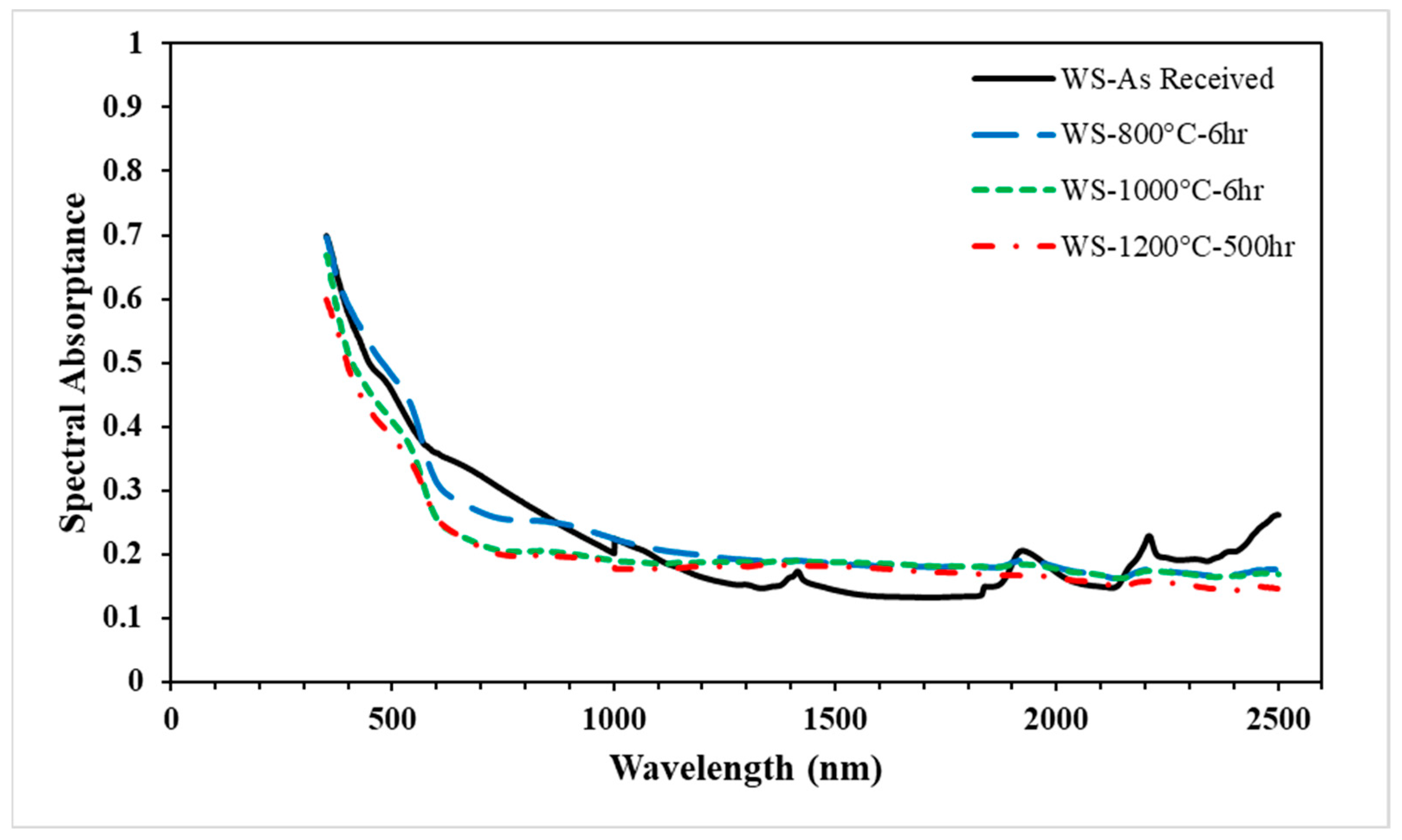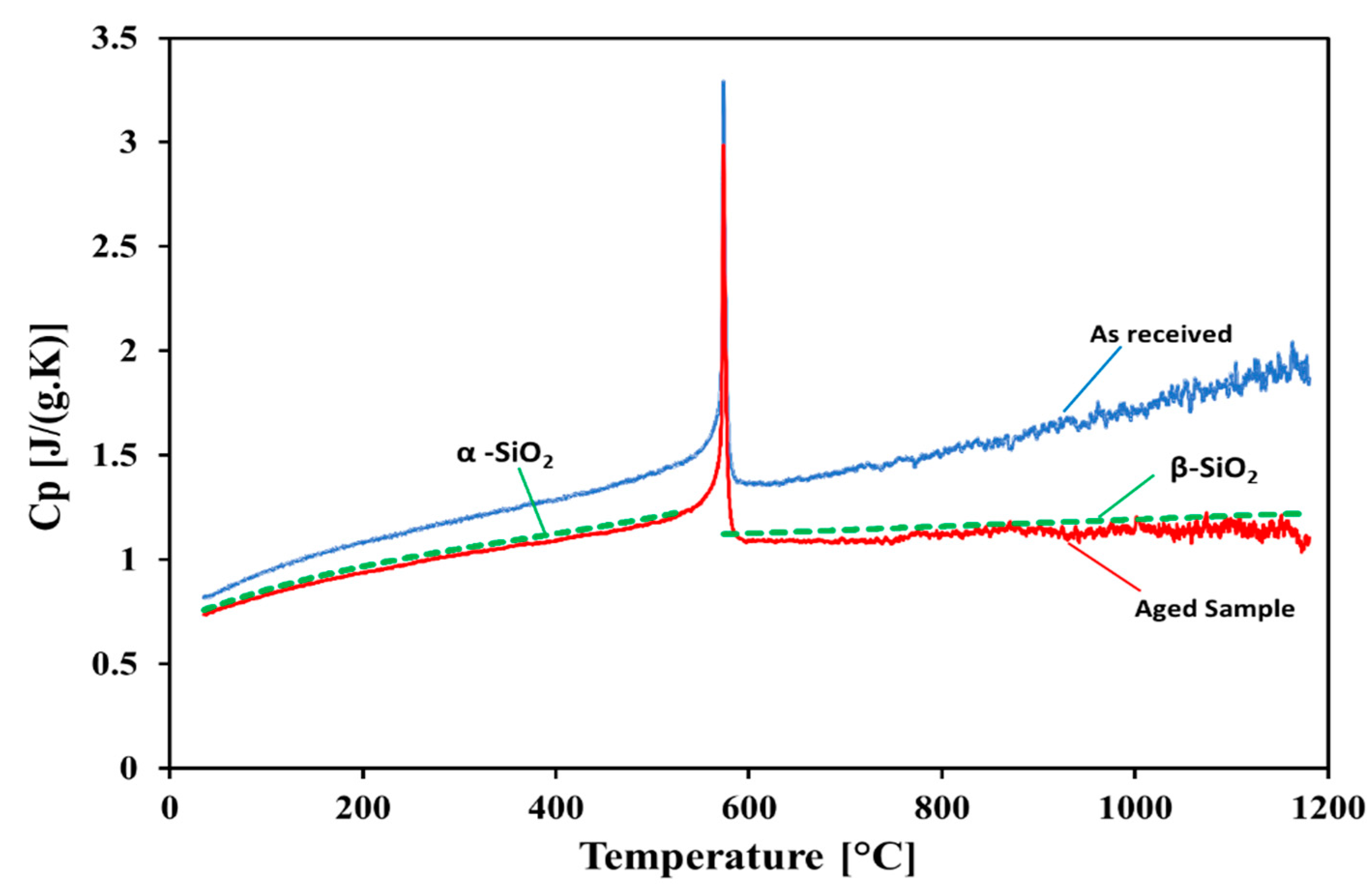There have been several TES solutions proposed over the past three decades. Ho [
4] reviewed and summarized the recent advances in solid-particle-based central receivers. One of the most widely accepted TES solutions is the use of molten salts [
5,
6]. Currently, the use of molten salts for thermal energy storage is limited to temperatures generally less than 600 °C due to technical restrictions. Another solution is the use of solid blocks to store energy during the day. This idea has been demonstrated with concrete blocks [
7,
8], but the temperatures are generally limited to less than 500 °C due to concrete’s properties, making this concept unsuitable for high-temperature applications. Furthermore, since solid blocks store sensible heat, their temperature profile during the discharging process causes a gradual decline in cycle efficiency. Yet another solution is to use sand as a storage medium [
9]. This concept was developed to work in conjunction with an air receiver. The sand is heated in an air–sand heat exchanger to a very high temperature. The sand then flows to a hot storage tank, and then to a fluidized bed cooler, where its heat is used to generate steam that feeds a steam power cycle. The colder sand returns either to the air–sand heat exchanger or is stored in a cold storage tank. This technology resolves the temperature limit issues faced in the solid-block concept. However, the main issue of an unfavorable temperature profile during discharging still persists.
TES in solid particles has been studied by a number of research groups. The research originated at Sandia National Laboratories (SNL) in the early 1980s examined the use of solid carriers as both a storage medium and working fluid for high temperatures [
10,
11,
12,
13,
14,
15,
16,
17]. The emphasis was on particle material selection and receiver design, along with the optical characterization of master beads and other particle materials. TES materials were also investigated in the past for varying applications. Zunft et al. [
18] quantified the heat losses from a subsystem TES, which consisted of rectangular storage composed of four parallel chambers filled with the ceramic storage material studied in the industrial regenerative thermal oxidizer. The temperature at full load reached 630 °C, and the total heat losses in a 24 h period amount to 930 kWh. An experimental packed-bed TES designed by CIEMAT-PSA [
19] was composed of an insulated stainless-steel vessel filled with 0.1 m
3 alumina spheres with a 9 mm diameter to investigate the specific costs of the storage subsystem under 20 EUR/kW
th. An air inlet temperature of 570 °C and different air mass flow rates have been investigated.
Tescari et al. [
20] evaluated the mechanical properties of structured reactors/heat exchangers in high-temperature heat storage via the cobalt oxide cyclic-redox scheme. Two different structures of honeycomb and perforated block and two different compositions were evaluated. During thermal cycling in the range of 800–1000 °C, different loads were applied to the samples while monitoring their length variations. Calderón et al. [
21] reviewed solid-particle materials to be used as both a heat-transfer fluid and a medium for thermal energy storage. The parameters and properties of solid particles were described from a materials science point of view by illustrating their function and their connection to the performance of the power plant and its durability. The interactions between solid particles and major system components were further discussed in this review. Furio et al. [
22] evaluated two coating methods for silica sand to improve the optical properties. They reported a 140% increase in optical properties. Specific heat capacity and energy density for different particulate materials were studied by Kang et al. [
23]. These particulate materials included silica sand, quartz sand, cristobalite, alumina, sintered bauxite, silicon carbide (SiC), and olivine sand. The results showed significant differences between the various materials, and that the olivine sand had the most favorable characteristics, followed by alumina and cristobalite. Proppants have good optical and mechanical properties to be used as heat transfer medium in concentrated solar power (CSP) systems [
24]. They are characterized by a high solar weighted absorptance higher than 90% “as received”, and they are noncorrosive materials. Proppants are available in large quantities; therefore, their cost is relatively low. However, fresh proppants are chemically unstable in oxidizing environments, and their solar weighted absorptance decreases when heated in air at 700 °C for many hours. Siegel et al. [
24] measured the radiative properties, solar weighted absorptance, and thermal emittance for different manufactured types of proppants, including CARBOHSP, CARBOACCUCAS, CARBOPROP, and Norton Masterbeads. The measurements of these materials were conducted in two different states, the “as received” state and after heating in the air between 700 °C and 1000 °C. The results showed a significant reduction in solar weighted absorptance in the “as received” particles over time and temperature. The effects of aging on the optical and thermal properties were studied for silicon carbide (SiC), silica sand (SiO
2), and hematite (Fe
2O
3) by Palacios et al. [
25]. The aging tests were conducted for 500 h at 750 °C and 900 °C. The results showed that the weighted solar absorptance for black SiC and iron oxide increased and decreased for SiO
2 with time. The highest absorptance and specific heat capacity values were recorded for the black SiC after aging at 900 °C for 500 h. Nie et al. [
26] measured the thermophysical and optical properties of nine different solid-particle samples to be used in a circulating solid-particle receiver. Those were alumina, silicon carbide, quartz sand, desert sand, river sand, yellow ceramist sand, grey ceramist sand, bauxite–cordierite ceramics, and black copper slag. Silicon carbide, grey ceramist sand, and bauxite–cordierite ceramics were found to be appropriate materials after the consideration of many factors. The most important factor was the high solar weighted absorptivity, even after heat treatment. Thermophysical, optical, and mechanical properties were measured for several particulate material samples extracted from different locations in the United Arab Emirates by Diago et al. [
27]. The results showed that the particulate samples appeared stable at temperatures ranging from 650 °C to 1000 °C. Solar absorptance decreased due to the particle phase change in which calcium carbonate was transformed into calcium oxide after heating to high temperatures. Aging tests for 500 h at 900 °C and thermal cyclic for 1500 cycles between 300 °C and 900 °C were conducted on silicon carbide (SiC) and CarboHSP
® 30/60 by Calderon et al. [
28]. Tests to determine solar absorptance, chemical composition, physical properties, and thermal characteristics, as well as morphologic analysis of the samples before and after thermal treatments were performed. The characterization results showed that SiC was more affected in its durability by thermal cycling than by constant-temperature aging treatment, while CarboHSP
® was affected by temperature aging rather than thermal cycling. SiC reacted with oxygen to form SiO
2 on the surface, with a positive effect on its solar absorptance. Nevertheless, with thermal cycles, the SiC particle surface became damaged, and the reaction continued with the additional newly exposed surface. Meanwhile, CarboHSP
® reduced its solar absorptance with the high temperatures only due to changes in its surface chemical composition. However, thermal cycling showed no negative effect on the properties of CarboHSP
®. Three different granular materials were characterized and tested by Díaz-Heras et al. [
29] for use as heat-transfer fluids and storage materials in CSP systems: sand, carbo Accurist ID50, and silicon carbide. Thermal aging at 900 °C for 500 h was conducted. The samples were also fluidized for 250 h at twice the minimum fluidization velocity (at ambient temperature). The properties of the particles before and after fluidization and before and after heating to a high temperature (900 °C) were investigated. The results showed that there was no significant change in their chemical compositions, and their specific heats and absorptivities did not vary notably after the tests. The main attractive property of SiC and Carbo is their very high absorptivity, which is around or over 0.9, while for the sand it is around 0.4. However, the abundance of sand makes it cheaper than SiC and Carbo by 4–5 times. Furthermore, sand’s lower density permits its particles to be transported/fluidized with lower pumping costs.
Preparations are underway to implement the improved modified concept in a pre-commercial integrated PHR–gas turbine system with a 1.3 MW
e rated capacity and six hours of thermal energy storage, making the incident thermal power of the PHR on the order of 7 MW
th with an operating temperature of 1200 °C [
30]. Such temperature durability and reliability of HTMs is very important. Three natural and low-cost materials were studied; namely white sand, red sand, ilmenite, and one engineered particulate material called Carbobead CP. This work was a continuation study of a TES system that was built at King Saud University, Riyadh, Saudi Arabia [
31,
32,
33,
34,
35,
36,
37,
38,
39,
40,
41,
42,
43,
44,
45]. With this work, we have extended our ongoing efforts in experimentation and modeling various options to enhance the heat transfer to or from sand or other particulates. The effect of aging on the particulate materials, optical properties, and thermophysical properties were studied. The results of this study could lead to a major reduction in the critical costs of a promising TES concept.


































